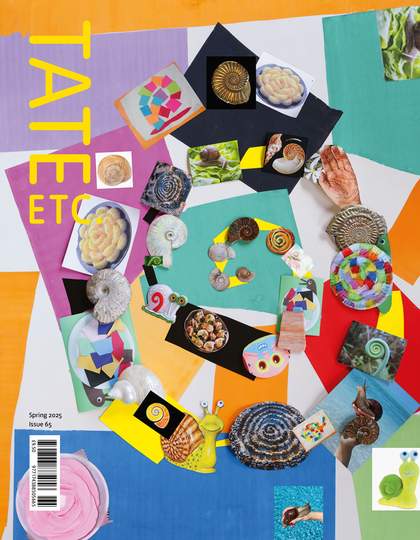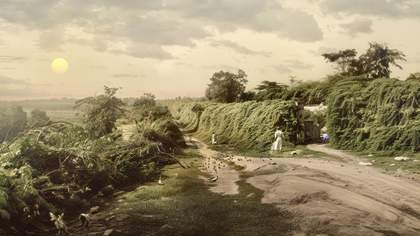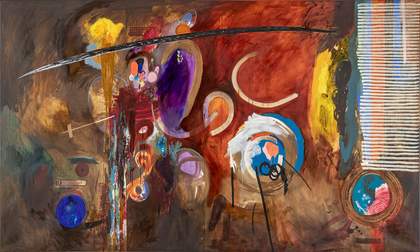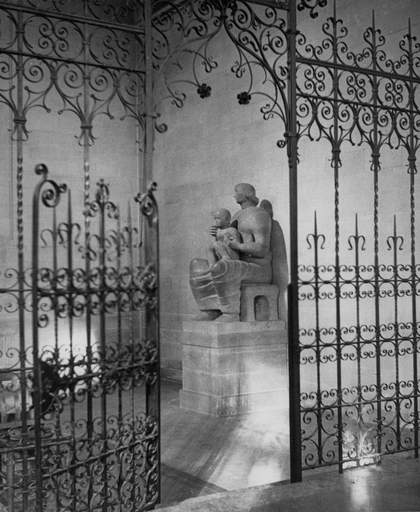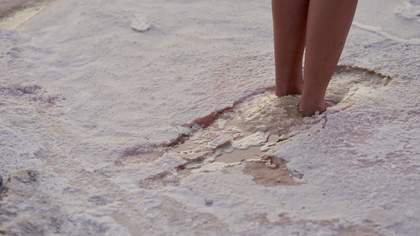
Hylozoic/Desires
The Hedge of Halomancy 2025
Video still
© Himali Singh Soin and David Soin Tappeser. All Rights Reserved, DACS/Artimage 2025
An immense impenetrable hedge of thorny trees and bushes, supplemented by stone wall and ditches, across which no human being or beast of burden or vehicle could pass without being subject to detention or search.
– John Strachey and Richard Strachey, The Finances and Public Works of India from 1869 to 1881 (1882)
If one conceives a thorned barrier, one must also imagine the bruises on its trespasser.
The telling of history is rarely accommodating of subversive stories, instead preferring to plot events within the margins of an existing record. Hylozoic/Desires is a duo comprising the poet and interdisciplinary artist Himali Singh Soin and the musician-composer David Soin Tappeser, who together practice a politics of recapturing dissensus, using sound, body and landscape to explore the potential of archives. Across multimedia projects, they nurture polyphonic narratives and forking cosmologies as creative approaches, creating sensory landscapes where rebellion, refusal and resistance flourish in unfettered formations.
This approach frames their enquiry into the salt regulations introduced by the East India Company in the 18th century – an economic policy that had far-reaching consequences on ecology, habitation and community life in colonial India through the 19th and 20th centuries. The history of salt and empire has often focused solely on the Salt March led by M.K. Gandhi in 1930 to violate the imperial monopoly on salt. Yet few historians have noted that the story of the colonial salt tax arcs back to 1756, when this naturally forming mineral came into the imperial fold through a strenuous taxation policy that sought to control the flow of salt from regions abundant in vast, natural salt pans, such as Sambhar in present-day Rajasthan, to lands under the purview of the East India Company, notably the Bengal Presidency.
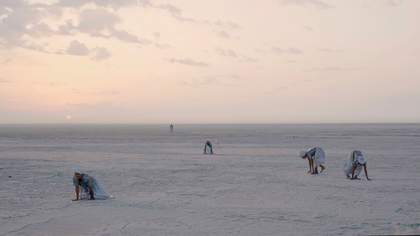
Hylozoic/Desires
The Hedge of Halomancy 2025
Video still
© Himali Singh Soin and David Soin Tappeser. All Rights Reserved, DACS/Artimage 2025
In 1803, the East India Company established the Inland Customs Line, transforming the checkposts installed across the trade routes of Bengal into an infrastructure intended to monitor and restrict the circulation of salt among Indigenous and other colonised communities. Imposing a heavy duty, this regime effectively criminalised regional practices of exchange, rendering salt, which had previously been accessible as commons, into a curtailed commodity.
However, these checkposts were found to be susceptible to breach by local tradesmen. As the Company’s ambitions grew, the Customs Line expanded and evolved, transforming into a continuous living barrier made of bushes, thorns, walls, ditches and checkposts, spanning 2,300 miles and manned by over 12,000 guards and gardeners. With no visual sources available in the imperial records of the hedge, this instrument of cartographic dominance and economic control now survives as a tangible yet absent entity, a spectre that haunts administrative and legal notations about its scale, upkeep and efficacy.
In The Hedge of Halomancy 2025, the film installation at the centre of their new display at Tate Britain, Hylozoic/Desires rescue the Customs Line from archival absence. By tuning into the echoes of fugitives – a diviner and courtesan, an occultist politician, countless local traders, and the vivid networks of non-human life that wove themselves around the hedge – Hylozoic/Desires uncover this forgotten chapter of colonisation to alert us to the origins of our contemporary crises.
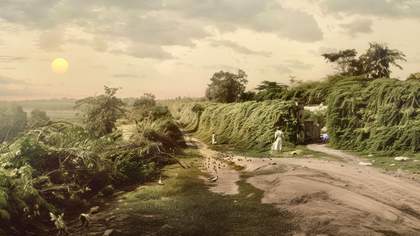
Hylozoic/Desires
The Hedge of Halomancy 2025
Video still
© Himali Singh Soin and David Soin Tappeser. All Rights Reserved, DACS/Artimage 2025
Halomancy is an ancient technique of divination by salt crystals, so The Hedge of Halomancy is projected onto a salt pan on the floor, recalling the pearlescent zones of salt in Sambhar where it was filmed. The space is approached through a textile screen that replicates motifs from the syncretic sites where these stories reside. The screen is woven in mashru, a blend of cotton and silk popular in Northern and Western India. Perforations in the screen evoke the façades of the chowki style of architecture prevalent in Sambhar. The embroidery and embellishments (ladders, climbing ropes, carabiners) on the fabric reference an ancient board game popular in the South Asian subcontinent called moksha patt, in which players navigate a hazardous route of snakes and ladders to win or lose, foisting their destiny on the roll of a dice. This sense of brute chance and ambient precarity recalls the fate of the smugglers who dared to defy the injunctions of the Company and circumvent the hedge.
Part-speculation, part-parable, in The Hedge of Halomancy we meet the many protagonists of this tale, as they are conjured by Hylozoic/Desires from scant references, marginalia, statistics, correspondence and novels of the period. Performing as Mayalee, a tawaif or courtesan mentioned briefly in imperial accounting books for refusing to forego her stipend of salt from imperial authorities, Singh Soin awakens us to salt’s plurality. For Mayalee, who is also an oracle and diviner, salt is magical, imbued with the power to access spiritual domains; it cannot be replaced by currency. For the flamingos that punctuate Sambhar and its skies, salt is epidermal, a pink hue drawn from the salt lakes they inhabit. For countless unnamed persons in imperial records, taxed salt is evidentiary, catalysed as a penal regime. For others, the tax on salt meant death: even as epidemics of diarrhoea and cholera raged, the Company provided no concessions on the price of salt, used in the making of saline solution.
When Mayalee first appears to us, we see only her limbs through the decorative lancets on a wall – signalling resistance in a raised fist, while her feet move to the rhythm of a march. As Mayalee moves through the salt pans her gestures are fluid and aerial, drawing connections with the earth and heavens. Singh Soin describes this movement as both ambivalent and opaque, which conveys the artists’ approach to reframing history. This duality, of time and its rupture, persists. Mayalee’s movements continue in the presence of Sambhar’s inhabitants – the birds that circle the sky, and the fish who wash up drowning in salt – a slow ecocide that is reminiscent of our present times.
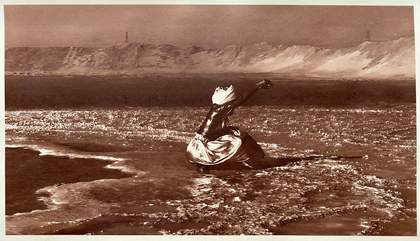
Hylozoic/Desires
The Halomancer 2024
© Himali Singh Soin and David Soin Tappeser. All Rights Reserved, DACS/Artimage 2025
Mayalee’s kinship with more-than-human life is not accidental; she engages in an imagined spiritual communication with Allan Octavian Hume, an imperial civil servant, ornithologist, spiritualist and a chronicler of the hedge, who would go on to establish the Indian National Congress. Hume’s trajectory, from an agent of the empire to anticolonial politics, guided by an interest in birds and the occult, is imagined as intersecting with Mayalee’s divination – a contact that could transform both of them. We see Mayalee whispering in the ruins of a colonial prison, her breath able to surpass all notions of a barrier. Her incantations and journeys are interspersed with footage captured by a hovering drone, which seems to patrol even the absence of the hedge; the permanently watchful eye of power tracks the world unceasingly. A blue tinge seeps into the frames – blue is the colour of salt as it evaporates, and cholera shrouds the skin with blue; blue, too, must be the bruises borne by those who waded this thicket to liberate salt from the tyranny of empire.
Hylozoic/Desires also fill in the visual gaps in the archive, utilising artificial intelligence tools to generate images of the hedge and its interlocutors. In these imagined pictures, the hedge appears as fecund, overgrown and defiant. Each such act of speculation undoes the erasure of the colonial archive. The silent, numb record of the salt tax is rendered replete with hauntings and possibilities.
The generated images, along with photographs taken in Sambhar, are further reproduced as salt prints, a historic photographic technique that was subsequently replaced by the albumen process, but is recovered here by the artists. This recovery extends to the aural – the soundscape of the film is composed using percussion instruments, interlaced with harmonies from regions stripped of cultural patronage by the onset of the British empire. Hylozoic/Desires note that, along with the epistemic violence, there is an erasure of musical archives. ‘For certain scenes we tried to imagine what a contemporary rendition of these extinct traditions could have sounded like,’ they explain. ‘Other scenes reference military marching bands: a colonial import that has been assimilated into the cultural fabric of India in the form of wedding bands, with [East India Company] uniforms intact. It felt generative to render this sonic history of appropriation and re-appropriation.’
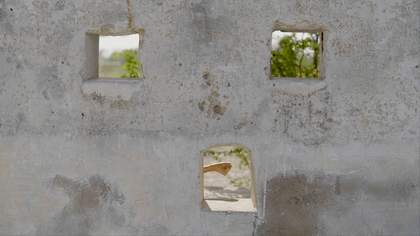
Hylozoic/Desires
The Hedge of Halomancy 2025
Video still
© Himali Singh Soin and David Soin Tappeser. All Rights Reserved, DACS/Artimage 2025
Through forays into archival notes, we learn that the hedge was eradicated by many forces – it was damaged by termites and rats, shaken by typhoons, and destroyed by fire in the uprising of 1857, which was framed in English history books as a ‘revolt’ but is popularly referred to as the First War of Independence in South Asia. Towards the end of the film, we see Mayalee wearing a Victorian dress made of recycled plastic waste from the salt marshes of the Rann of Kutch – also on display at Tate Britain. Covering her body with contemporary notions of modesty, she walks through a salt-pan landscape along a railway track, another symbol of imperial cartography. Her entanglement with these symbols constructs a frame replete with narrative multiplicity – is Mayalee claiming this dividing line, or is this act, as Hylozoic/Desires suggest, unclear and unresolved? ‘Has Mayalee also turned in a certain manner, against her own people, or is she taking her first steps towards liberation? We don’t have an answer – she is complex, both an archetype and an individual, both honourable and an outcast… the very essence of the hedge as a barrier: its non-duality, its mutuality and its unpredictability.’
Through this exploration of counter-histories, salt – a docile presence in kitchen cabinets – is recast as a mercurial substance: ‘of the spirit, with an occult, orphic nature’, says Singh Soin. Springing up from the place where records go silent, The Hedge of Halomancy conjures the colonial past as a source of reverberations, each branching into many irreducible potentialities.
Art Now: Hylozoic/Desires, at Tate Britain until 25 August. Salt Cosmologies is at Somerset House until 27 April.
Arushi Vats is a curator and writer currently pursuing a PhD in History of Art at the University of Cambridge, supported by the Gates Cambridge Scholarship.
Supported by The Bukhman Foundation. With additional support from the Art Now Supporters Circle and Tate Americas Foundation. Curated by Dominique Heyse-Moore, Senior Curator, Contemporary British Art and Nathan Ladd, Curator, Contemporary British Art.

